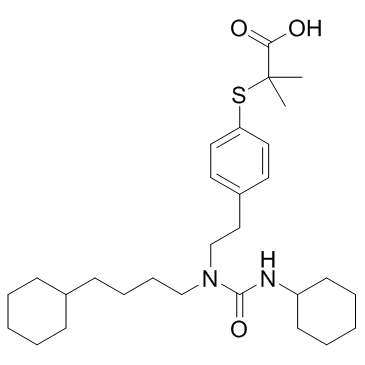265129-71-3
| Name | gw 7647 |
|---|---|
| Synonyms |
2-[(4-{2-[(4-Cyclohexylbutyl)(cyclohexylcarbamoyl)amino]ethyl}phenyl)sulfanyl]-2-methylpropanoic acid
Tocris-1677 Propanoic acid, 2-[[4-[2-[[(cyclohexylamino)carbonyl](4-cyclohexylbutyl)amino]ethyl]phenyl]thio]-2-methyl- GW7647 2-[4-[2-[4-cyclohexylbutyl(cyclohexylcarbamoyl)amino]ethyl]phenyl]sulfanyl-2-methylpropanoic acid GW-7647 |
| Description | GW7647 is a potent PPARα agonist, with EC50s of 6 nM, 1.1 μM, and 6.2 μM for human PPARα, PPARγ and PPARδ, respectively. |
|---|---|
| Related Catalog | |
| Target |
PPARα:6 nM (EC50, Human PPARα) PPARγ:1.1 μM (EC50, Human PPARγ) PPARδ:6.2 μM (EC50, Human PPARδ) |
| In Vitro | GW7647 (1 μM) causes a significant increase of PDZK1 protein expression to 129.7 ± 6.5% of vehicle treated control in Caco2BBE cells in the absence and presence of IL-1β. GW7647 also attenuates the IL-1β-mediated decrease in PDZK1 expression[1]. GW7647 (50 nM) stimulates the PI3K phosphorylation followed by the Akt (Ser473) phosphorylation, which induces NOS1 phosphorylation increased the amounts of NO released in the stripped antral mucosa. GW7647 (50 nM) enhances the initial phase of Ca2+-regulated exocytotic events stimulated by ACh in antral mucous cells, but GW7647 alone does not evoke any exocytotic event. GW7647 plus ACh stimulates the effects of wortmannin (50 nM) and AKT-inh (100 nM) on the exocytotic events in antral mucous cells[2]. GW 7647 (100 nM) reduces the AQP9 protein abundance by 43%, but it shows not significant effect at 10 and 1,000 nM in WIF-B9 hepatocytes. GW 7647 (100 nM) causes a 24% reduction in AQP9 protein abundance in HepG2 cells, however, it does not significantly increase the protein abundance of L-FABP in HepG2 hepatocytes[3]. |
| In Vivo | GW7647 (3 mg/kg per day) does not prevent the development of cardiac hypertrophy, but it prevents the decline in left ventricular ejection fraction in vivo[4]. |
| Animal Admin | Newborn New Zealand White rabbits of either sex (7 days old, 90-200 g) are anesthetized with inhaled isofluorane (2%), and are subjected to an aorto-caval shunt to induce volume-overload cardiac hypertrophy. The presence of a successful fistula is verified at postsurgical days 7 and 13 by color flow doppler that visualizes a physical shunt between the abdominal aorta and the inferior vena cava in both an axial and transverse plane. This is further validated by an enlarged inferior vena cava. After validation, the animals in shunt group are randomly assigned to receive an intraperitoneal injection of vehicle (dimethyl sulfoxide, the solvent of GW7647) or GW7647 (3 mg/kg per day; EC50=6 nM for PPARα) twice a day for 14 days. Animals that undergo surgery to create shunt, but consequently the shunt either not exhibiting or closed, are excluded from the study. Left ventricular ejection fraction (%) and other cardiac parameters are assessed by transthoracic echocardiography at postsurgical days 7 and 13. At 21 days of age (14 days post surgery), all animals are euthanized with Na+ pentobarbital, and hearts are removed for isolated biventricular working heart perfusions. |
| References |
| Density | 1.1±0.1 g/cm3 |
|---|---|
| Boiling Point | 693.9±55.0 °C at 760 mmHg |
| Molecular Formula | C29H46N2O3S |
| Molecular Weight | 502.752 |
| Flash Point | 373.5±31.5 °C |
| Exact Mass | 502.322906 |
| PSA | 94.94000 |
| LogP | 8.59 |
| Vapour Pressure | 0.0±2.3 mmHg at 25°C |
| Index of Refraction | 1.569 |
| Storage condition | 2-8℃ |
| Personal Protective Equipment | Eyeshields;Gloves;type N95 (US);type P1 (EN143) respirator filter |
|---|---|
| RIDADR | NONH for all modes of transport |
